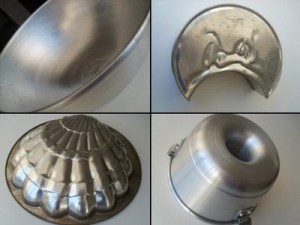 Cake Pans come in a wide range of shapes, sizes, and materials – from traditional to specialty pans, miniature pans to wedding cake pans, made from metal or silicone.
Cake Pans come in a wide range of shapes, sizes, and materials – from traditional to specialty pans, miniature pans to wedding cake pans, made from metal or silicone.Traditional cake pans
Every baker, even the home and hobby baker should have a selection of cake pans. Traditional 8" or 10" round pans are essential for 2-layered birthday cakes. Rectangular pans are used for sheet cakes. A spring form usually consists of two pieces, the bottom and the ring that attaches around it.
Contrary to the one piece pans they make the removal of the cake extremely easy. Pans for a Bundt cake look like an inverted flower pot with a cylinder in the center. Usually they will give the cake a wavy pattern on the outside surface.
Specialty Cake Pan Designs
While cakes from traditional pans require some decorating skills to make them an eye-catcher, this job can be made easier by using specialty cake pans.
Three categories of specialty pans:
1) Shaped Pans cause the batter to set in a certain form while baking so that no sculpturing or carving is necessary to make the cake match a desired theme. These pans are produced in shapes of cars, animals, or different kind of fruit. They are especially popular for birthdays to match the interests of the celebrated person.
2) Character Pans replicate the images of favorite TV show or movie characters. Children often make requests to have a cake in the form of their most-liked hero, toy, or cartoon character. It is important to keep in mind that most of these character pans are licensed and these cakes cannot be made for sale.
3) Three dimensional pans allow giving your shaped cake additional spin. Often they are come as two parts. The two cakes you get are then “glued” together with buttercream or royal icing. With this technique perfectly ball shaped cakes, or cakes in the form of a giant cupcake can be created with relative ease.
Specialty Cake Pan Materials
Traditionally most cake pans were made from metal, but also glass or ceramic forms can be found. Now many metal cake pans are produced with a non-stick surface to ease the removal of the cake from the form. It is still recommended to grease the pan using baking spray or brushing some oil and sprinkling flour onto the pan to ensure that you will be able to get out the cake after baking.
A small revolution was brought on with the introduction of silicone cake pans. Because of their bendable structure removing a cake is no problem anymore. In order to give your silicone form support it is suggested to place it on a baking sheet when filling in the batter and baking.
Adjusting batter amounts for specialty cake pans
When using specialty cake pans attention has to be paid in choosing the right amount of batter. If this is neglected and you just blindly follow the recipe you have at hand you might encounter some unpleasant surprises. I am sure you do not want to experience an oven full of overflowing batter or a pan not even filled out with batter.
Find out more about the right techniques for adjusting the batter amount for specialty cake pans on www.specialtycakecreations.com and Specialty Cake Pans